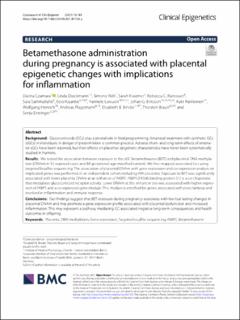| dc.contributor.author | Czamara, Darina | |
| dc.contributor.author | Dieckmann, Linda | |
| dc.contributor.author | Röh, Simone | |
| dc.contributor.author | Kraemer, Sarah | |
| dc.contributor.author | Rancourt, Rebecca C. | |
| dc.contributor.author | Sammallahti, Sara | |
| dc.contributor.author | Kajantie, Eero Olavi | |
| dc.contributor.author | Laivuori, Hannele | |
| dc.contributor.author | Eriksson, Johan G. | |
| dc.contributor.author | Räikkönen, Katri | |
| dc.contributor.author | Henrich, Wolfgang | |
| dc.contributor.author | Plagemann, Andreas | |
| dc.contributor.author | Binder, Elisabeth B. | |
| dc.contributor.author | Braun, Thorsten | |
| dc.contributor.author | Entringer, Sonja | |
| dc.date.accessioned | 2023-01-23T09:15:18Z | |
| dc.date.available | 2023-01-23T09:15:18Z | |
| dc.date.created | 2022-01-11T11:19:36Z | |
| dc.date.issued | 2021 | |
| dc.identifier.citation | Clinical Epigenetics. 2021, 13 (1), . | en_US |
| dc.identifier.issn | 1868-7075 | |
| dc.identifier.uri | https://hdl.handle.net/11250/3045171 | |
| dc.description.abstract | Background Glucocorticoids (GCs) play a pivotal role in fetal programming. Antenatal treatment with synthetic GCs (sGCs) in individuals in danger of preterm labor is common practice. Adverse short- and long-term effects of antenatal sGCs have been reported, but their effects on placental epigenetic characteristics have never been systematically studied in humans. Results We tested the association between exposure to the sGC betamethasone (BET) and placental DNA methylation (DNAm) in 52 exposed cases and 84 gestational-age-matched controls. We fine-mapped associated loci using targeted bisulfite sequencing. The association of placental DNAm with gene expression and co-expression analysis on implicated genes was performed in an independent cohort including 494 placentas. Exposure to BET was significantly associated with lower placenta DNAm at an enhancer of FKBP5. FKBP5 (FK506-binding protein 51) is a co-chaperone that modulates glucocorticoid receptor activity. Lower DNAm at this enhancer site was associated with higher expression of FKBP5 and a co-expressed gene module. This module is enriched for genes associated with preeclampsia and involved in inflammation and immune response. Conclusions Our findings suggest that BET exposure during pregnancy associates with few but lasting changes in placental DNAm and may promote a gene expression profile associated with placental dysfunction and increased inflammation. This may represent a pathway mediating GC-associated negative long-term consequences and health outcomes in offspring. | en_US |
| dc.language.iso | eng | en_US |
| dc.publisher | BioMed Central | en_US |
| dc.rights | Navngivelse 4.0 Internasjonal | * |
| dc.rights.uri | http://creativecommons.org/licenses/by/4.0/deed.no | * |
| dc.title | Betamethasone administration during pregnancy is associated with placental epigenetic changes with implications for inflammation | en_US |
| dc.title.alternative | Betamethasone administration during pregnancy is associated with placental epigenetic changes with implications for inflammation | en_US |
| dc.type | Peer reviewed | en_US |
| dc.type | Journal article | en_US |
| dc.description.version | publishedVersion | en_US |
| dc.source.pagenumber | 17 | en_US |
| dc.source.volume | 13 | en_US |
| dc.source.journal | Clinical Epigenetics | en_US |
| dc.source.issue | 1 | en_US |
| dc.identifier.doi | 10.1186/s13148-021-01153-y | |
| dc.identifier.cristin | 1978126 | |
| cristin.ispublished | true | |
| cristin.fulltext | original | |
| cristin.qualitycode | 1 | |

